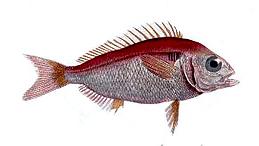
The panga, or panga seabream is a species of marine ray-finned fish belonging to the family Sparidae, which includes the seabreams and porgies. It is the only species in the monospecific genus Pterogymnus. This species is endemic to the coasts of South Africa. The panga is an important species in commercial line fisheries off South Africa.

Pagellus is a genus of marine ray-finned fish belonging the family Sparidae, which includes the seabreams and porgies. These fishes are found in the eastern Atlantic Ocean, the Mediterranean Sea and the western Indian Ocean.

Lithognathus is a genus of marine ray-finned fish belonging to the family Sparidae, which includes the seabreams and porgies. Species in this genus are given the common name of steenbras. The genus is found in the Eastern Atlantic Ocean from southwestern Europe to South Africa and into the southwestern Indian Ocean.

Diplodus is a genus of marine ray-finned fish belonging the family Sparidae, which includes the seabreams and porgies. These fishes are found in the Atlantic Ocean, the Mediterranean Sea and the western Indian Ocean.

Sparidentex is a genus of ray-finned fish belonging to the family Sparidae, which includes the seabreams and porgies. These fishes are found in the Indian Ocean.

Acanthopagrus is a genus of marine ray-finned fishes belonging to the family Sparidae, the sea breams and porgies. The fish in this genus are found in the Indian and western Pacific Oceans.

Rhabdosargus is a genus of ray-finned fish belonging to the family Sparidae, which includes the seabreams and porgies. These fishes are found in the southeastern Atlantic Ocean and throughout the Indo-West Pacific, although mainly in the western Indian Ocean.

Polysteganus is a genus of ray-finned fish belonging to the family Sparidae, which includes the seabreams and porgies. The fishes in this genus are found in the Indian Ocean.

Polyamblyodon gibbosum, the knife-back seabream or cristie, is a species of marine ray-finned fish belonging to the family Sparidae, which includes the seabreams and porgies. This species is endemic to the southwestern Indian Ocean.

Crenidens is a small genus of three species of seabream from the family Sparidae from the western Indian Ocean. It was previously regarded as monotypic, with the sole species being the Karenteen sea bream Crenidens crenidens but two other species are now accepted as valid species, separate from the type species, C. crenidens.
Polysteganus undulosus, the seventyfour seabream, is a species of marine ray-finned fish belonging to the family Sparidae, which includes the seabreams and porgies. This species is endemic to the southwestern Indian Ocean off Southern Africa.

Spondyliosoma is a genus of marine ray-finned fish belonging to the family Sparidae, which includes the seabreams and porgies. The genus contains two species, one, the black seabream, from the eastern Atlantic Ocean and the other, the steentjie seabream, from the western Indian Ocean.

Rhabdosargus haffara, the haffara seabream or Haffara stumpnose, is a species of marine ray-finned fish belonging to the family Sparidae, which includes the seabreams and porgies. This fish is found in the northwestern Indian Ocean.

Chrysoblephus is a genus of marine ray-finned fishes belonging to the family Sparidae, the sea breams and porgies. The fish in this genus are found in the western Indian Ocean and southeastern Atlantic Ocean.

Gymnocrotaphus is a monospecific genus of marine ray-finned fish belonging to the family Sparidae, which includes the seabreams and porgies. The only species in the genus is the Gymnocrotophus curvidens, the Janbruin, an endemic to the coasts of South Africa.

Pachymetopon is a genus of marine ray-finned fishes belonging to the family Sparidae, which includes the seabreams and porgies. The species in this genus are endemic to Southern Africa.

Pachymetopon grande, the bronze seabream or blue hottentot, is a species of marine ray-finned fishes belonging to the family Sparidae, which includes the seabreams and porgies. This species is found in the southwestern Indian Ocean. It is an important spoecies for recreational fisheries in South Africa and for subsistence fisheries too.

Polyamblyodon is a genus of marin ray-finned fishes belonging to the family Sparidae, which includes the seabreams and porgies. The fishes in this genus are found in the Western Indian Ocean.

Polyamblyodon germanum, the German seabream, is a species of marine ray-finned fish in the family Sparidae, which includes the seabreams and porgies. This species is found in the southwestern Indian Ocean.

The Dane seabream, also known as the Dane, is a species of marine ray-finned fish belonging to the family Sparidae, which includes the seabreams and porgies. The Dane seabream is the only species in the monospecific genus Porcostoma. This species is endemic to the southwestern Indian Ocean off the coast of Southern Africa.

















